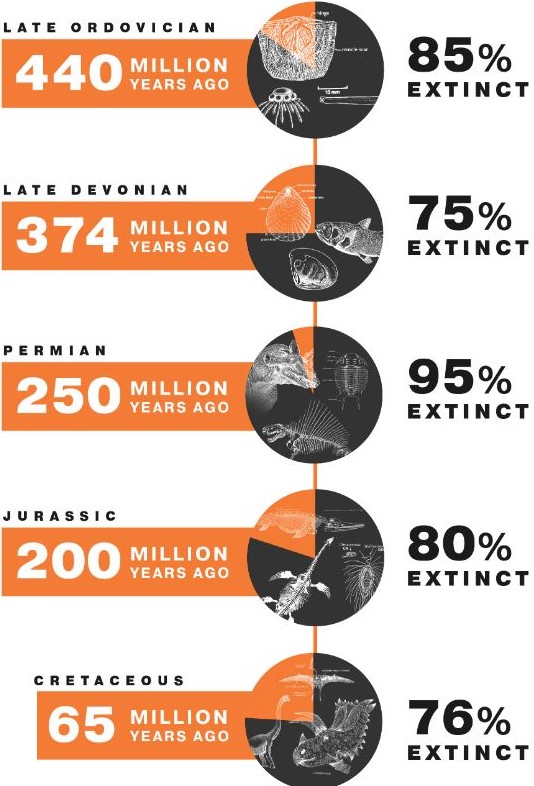A mass extinction is classified as a sharp rise in the rate of extinction. Mass extinction event are caused by catastrophic events resulting in rapid environmental change. Five mass extinctions have been identified through the fossil record.

Ordovician Extinction: 440 million years ago
The Late Ordovician was one of the coldest times in the last 600 million years of Earth’s history. The landmasses of Gondwana ended up on the South Pole during the late Ordovician causing massive glaciers to form. The shallow seas drained and sea levels to drop resulting in a mass extinction.
Extinction: 85% of species
Devonian Extinction: 365 million years ago
This mass extinction was caused by a combination of stresses including; excessive sedimentation, rapid global warming or cooling, meteorite or comet impacts or massive nutrient runoff from the continents.
Extinction: 75% of species and 20% of families
Permian Extinction: 250 million years ago
During the Permian Period there was volcanic activity on a massive scale. There was a huge outpouring of lava that covered a large expanse of Siberia in a flood basalt event, now called the Siberian Traps. This event is believed to have increased air and sea temperatures and released toxic amounts sulfur dioxide and carbon dioxide into the atmosphere. In turn this lead to high acidity in the oceans. This period is called the ‘Great Dying’.
Extinction: 95% of marine species and 70 % of terrestrial species
Triassic-jurassic Extinction: 200 million years ago
During this time the supercontinent of Pangea began to break apart. As North America separated from Africa and the Atlantic Ocean began to form, volcanic activity on a massive scale introduced carbon dioxide into the atmosphere. This led to global warming and changes to the oceans.
Extinction: 80% of species
Cretaceous-tertiary Extinction: 65 Million Years Ago
Asteroid 10km in diameter hit the Earth in the Yucatan Peninsula Mexico. A dust cloud encircled the planet, reducing the amount of sunlight and preventing photosynthesis. Plants and plankton died, then herbivores and carnivores. Dust and debris falling back to Earth may have triggered wildfires.
Extinction: 75% of species
Are we on the verge of the 6th Extinction?

